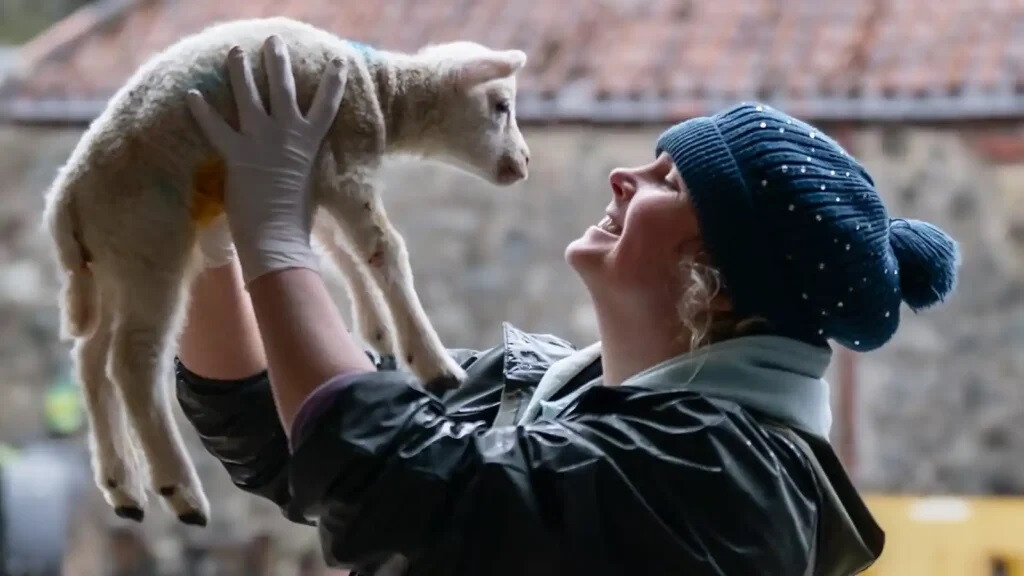
ESSEX, New York – In the pre-dawn darkness, under a canopy of stars sharp against the frigid air, Kristin Kimball guides a visitor into the heart of her bustling barn. The breath of both humans and ewes hangs suspended in the beam of headlamps, illuminating a scene of quiet anticipation. "It's about 5:30 a.m., and the sun is just beginning to think about rising," Kimball remarks, her voice a calm anchor in the sea of soft bleating. Suddenly, her light catches on a heartwarming sight: an ewe nestled amongst three tiny, newborn lambs. "Come on, let's go," she murmurs, gently ushering the new family into a separate pen, a sanctuary for crucial early bonding. "I just want to ensure she has milk and that all the babies are doing well."
Just days prior, a casual dinner conversation with Kimball and her husband, Mark, close friends and neighbors in New York's Champlain Valley, took a turn towards the restorative power of nature. A confession of feeling listless was met with Kimball's simple yet profound remedy: immersion in the farm's lambing season.
Kneeling in the fragrant hay, the air thick with the promise of warmer days, one is immediately enveloped by the curious advances of newborn lambs. The sensation is akin to being swarmed by long-legged, albeit endearingly clumsy, poodles – a fitting analogy for the chaotic yet comforting reality of lambing season on this northern New York farm. "These look like nice, strong babies; they're going to do just fine," Kimball observes with an experienced eye, her words a quiet reassurance.
This spring has been generous, a season of abundant and healthy births. Kimball anticipates around 400 new lives gracing her farm before the final ewe has lambed. The only significant challenge this year is the persistent, unseasonable cold. Situated close to the Canadian border, the farm has experienced nights dipping to a biting 19 degrees Fahrenheit. Yet, the resilient newborns have thus far thrived. "They're just born, and they pop up and start nursing, which is exactly what you want to see," Kimball explains, her admiration evident.
Despite the demanding hours and the constant battle against the lingering winter chill, the allure of the barn remains strong. Spending time amidst the flock, sometimes accompanied by the watchful presence of the shaggy shepherd dog, offers a unique tranquility. Surprisingly, Kimball notes that pregnant ewes, far from being skittish, are often at their most welcoming during this period.
A cornerstone of the lambing process is the establishment of a strong bond between the ewe and her offspring, a primal connection that ensures the lamb's nourishment and care. "This ewe, for example, is flooded with hormones, her system coursing with oxytocin," Kimball explains, gesturing towards a particularly attentive mother. "She's in a mood to be around other creatures and just give love." This maternal instinct, however, is highly selective; within hours of birth, a ewe will only accept her own lambs, actively rejecting others. Similarly, lambs quickly learn to identify their mothers through a symphony of olfactory, visual, and auditory cues. This early recognition is vital for survival, allowing lambs to avoid aggression from unrelated ewes and remain close to their source of sustenance.
The birthing process is not always seamless. One afternoon, the calm of the barn is punctuated by the challenge of a ewe experiencing a breech delivery. "We're going to need to flip the baby around and pull it out," Kimball states, her tone matter-of-fact yet focused. While a fairly common complication, it demands skillful intervention. Kimball calls upon Anne Brown, a fellow farmhand, and together they work with practiced efficiency. While Brown gently restrains the ewe, Kimball reaches inside, her experienced hand navigating the delicate situation. "It's like a puzzle because she doesn't know if she's got two or three in there," Brown remarks, her concern mirroring Kimball's intense concentration. "I feel a back but no legs," Kimball murmurs, "Now I'm going to find which legs go with this lamb." With focused determination, she manages to reposition the lamb, guiding it out, followed swiftly by two more tiny siblings. "She's licking the lamb off, which dries the lamb," Kimball says, a note of relief in her voice. "That's important when it's cold, and they're bonding."
A shared grin passes between the two women as the visitor sits nearby, humbled by the raw beauty and demanding nature of the process. Soon, the warmth of wriggling lambs seeking comfort once again becomes an embrace. "Aren't they the best?" Kimball says softly, a lamb nestled in her arms. "They're so cute. Each time we have a new litter born, it's just fun and beautiful."
The signs of Kimball's weariness are undeniable; lambing is arduous, marked by long hours and sleepless nights. Yet, an undeniable happiness radiates from her. There is a profound joy in this season, in the tangible work, and in the constant arrival of new life – a powerful reminder of nature's enduring cycle, even in the face of a lingering winter.
[Copyright (c) Global Economic Times. All Rights Reserved.]






























